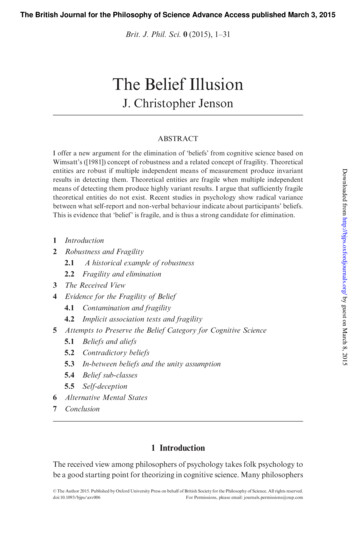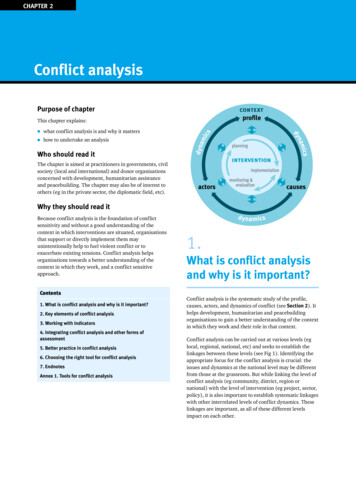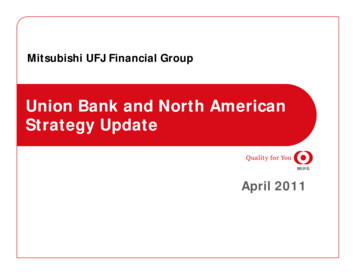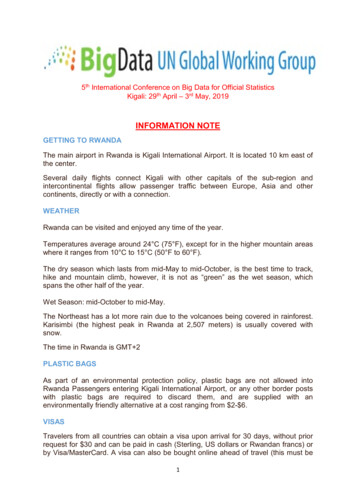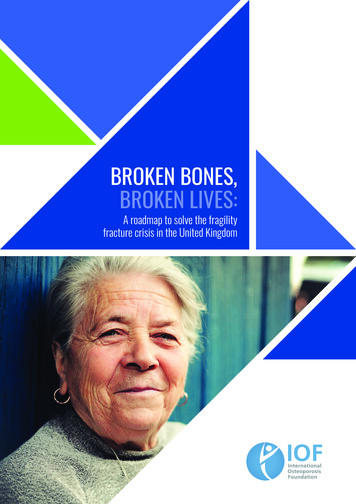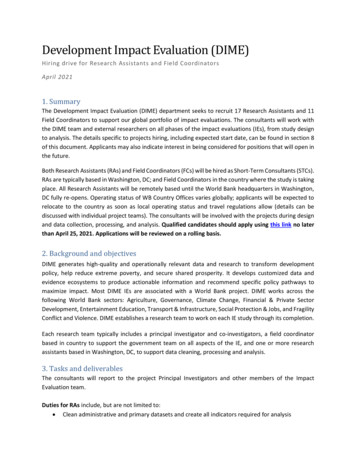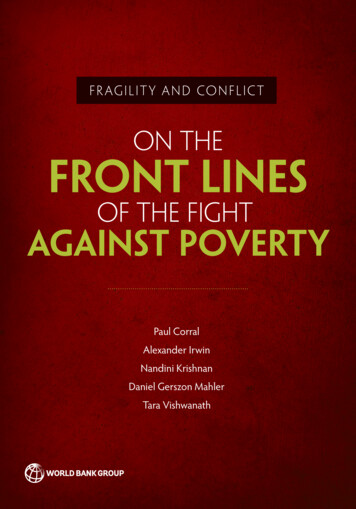
Transcription
F R A G I L I T Y A N D CO N F L I C TON THEFRONT LINESOF THE FIGHTAGAINST POVERTYPaul CorralAlexander IrwinNandini KrishnanDaniel Gerszon MahlerTara Vishwanath
Fragility and Conflict
Fragility and ConflictOn the Front Lines of theFight against PovertyPaul Corral, Alexander Irwin, Nandini Krishnan,Daniel Gerszon Mahler, and Tara Vishwanath
2020 International Bank for Reconstruction and Development / The World Bank1818 H Street NW, Washington, DC 20433Telephone: 202-473-1000; Internet: www.worldbank.orgSome rights reserved1 2 3 4 23 22 21 20This work is a product of the staff of The World Bank with external contributions. The findings, interpretations,and conclusions expressed in this work do not necessarily reflect the views of The World Bank, its Board of Executive Directors, or the governments they represent. The World Bank does not guarantee the accuracy of the dataincluded in this work. The boundaries, colors, denominations, and other information shown on any map in thiswork do not imply any judgment on the part of The World Bank concerning the legal status of any territory or theendorsement or acceptance of such boundaries.Nothing herein shall constitute or be considered to be a limitation upon or waiver of the privileges and immunitiesof The World Bank, all of which are specifically reserved.Rights and PermissionsThis work is available under the Creative Commons Attribution 3.0 IGO license (CC BY 3.0 IGO) http://creativecommons.org/licenses/by/3.0/igo. Under the Creative Commons Attribution license, you are free to copy, distribute, transmit, and adapt this work, including for commercial purposes, under the following conditions:Attribution—Please cite the work as follows: Corral, Paul, Alexander Irwin, Nandini Krishnan, Daniel GerszonMahler, and Tara Vishwanath. 2020. Fragility and Conflict: On the Front Lines of the Fight against Poverty. Washington, DC: World Bank. doi:10.1596/978-1-4648-1540-9. License: Creative Commons Attribution CC BY 3.0IGOTranslations—If you create a translation of this work, please add the following disclaimer along with the attribution: This translation was not created by The World Bank and should not be considered an official World Banktranslation. The World Bank shall not be liable for any content or error in this translation.Adaptations—If you create an adaptation of this work, please add the following disclaimer along with the attribution: This is an adaptation of an original work by The World Bank. Views and opinions expressed in the adaptationare the sole responsibility of the author or authors of the adaptation and are not endorsed by The World Bank.Third-party content—The World Bank does not necessarily own each component of the content contained withinthe work. The World Bank therefore does not warrant that the use of any third-party-owned individual component or part contained in the work will not infringe on the rights of those third parties. The risk of claimsresulting from such infringement rests solely with you. If you wish to reuse a component of the work, it is yourresponsibility to determine whether permission is needed for that reuse and to obtain permission from thecopyright owner. Examples of components can include, but are not limited to, tables, figures, or images.All queries on rights and licenses should be addressed to World Bank Publications, The World Bank Group, 1818H Street NW, Washington, DC 20433, USA; e-mail: pubrights@worldbank.org.ISBN: 978-1-4648-1540-9ISBN (electronic): 978-1-4648-1547-8DOI: 10.1596/978-1-4648-1540-9Cover design: Bill Pragluski, Critical Stages, LLC.Library of Congress Control Number: 2020933566
ContentsAcknowledgments. ixAbout the Authors. xiAbbreviations.xiiiIntroduction.1An Urgent Challenge—and a Window to Respond.1Book Structure.3Note.3References.31.Fragility, Conflict, and Extreme Poverty.5Key Messages.5Background: Living and Dying in a Two-Speed World.5Data Deprivation in FCS.7Overcoming Data Deprivation.10A Clearer Picture of Global Poverty.13Better Analysis in FCS Shows that Global Poverty Has BeenUnderestimated.14Poverty Rates Have Risen in FCS, as They Fall Elsewhere.15Economies Chronically in FCS Are Driving the allenges in Multiple Dimensions.23Key Messages.23Seeing Beyond Monetary Poverty .23Losing Human Capital—Where It Is Needed Most.26FCS and Growth: Negative Associations.28v
Picturing a Better g-Term Effects of Conflict on Poverty and Welfare.33Key Messages.33Introduction.33Conflict through a Human Capital Lens.33The Impact of Conflict on Human Capital: Health.34The Impact of Conflict on Human Capital: Education.37Conflict and Intergenerational Socioeconomic Mobility.40Conflict’s Impact on Labor Market Outcomes.43Impact on Productive Assets and Income-Earning Activities .44Conflict-Induced Displacement: How Do Refugees ImpactHost Communities? .45Adding It All Up: Conflict Imposes Heavy Costs that Extendto Future Generations .47Notes.48References.494.Patterns of Fragility—Understanding Diversity in Country Profiles. 53Key Messages.53Introduction.53Cluster Analysis for Creating Country Typologies.54An Empirical Approach to Exploring Patterns of Fragility.55Country Typologies .59Cluster Profiles and Entry Points for Policy —Directions for Action on Fragility and Poverty.67Addressing Data Deprivation .67Monitoring Fragility Markers.70Prioritizing and Focusing Policy Action .71Privileging Prevention.73Fighting Poverty on the Front Lines .74vi Contents
Notes.75References.76Appendix A: Computing Proximity to Conflict.77Appendix B: Methods to Address Poverty Data Deprivation.79Appendix C: Classification Tree of FCS for Fiscal Year 2020.89Appendix D: Data Sources for Cluster Analysis.91Appendix E: Governance Index.95Boxes1.1Assumptions Made to Overcome Data Deprivations.101.2Tackling Data Deprivation at the Country Level: Lessons from Somalia.111.3Backcasting and Forecasting FCS and Poverty .162.1The Multidimensional Poverty Measure.242.2The Human Capital Index.273.1Unfortunate Mothers and Unfortunate Children: Intergenerational HealthImpacts of Civil Conflict in Nepal.363.2The Educational Impact of Shocks in Utero: Children Exposed tothe Rwandan Genocide during Fetal Development Showed ReducedEducational Attainment 18 Years Later.383.3Education Is Forbidden: The Boko Haram Conflict Reduced SchoolEnrollment and Educational Attainment in North-East Nigeria.393.4Measures of Intergenerational Mobility.413.5Can Refugees Boost Welfare among Host Populations? Evidence fromthe Syrian Crisis.474.1Clustering in Action.564.2Mixture Models: Latent Profile Analysis.575.1Counting the Displaced.68B.1Using Elasticities to Nowcast and Forecast Poverty .83Figures1.1The World’s Population Living in Proximity to Conflict Deaths HasDoubled in 10 Years.61.2The Number of Displaced People Is on the Rise.61.3Patterns of International Poverty Data Deprivation in FCS.9B1.2.1 Poverty across Population Groups in Somalia, 2017.131.4The 43 Economies with the Highest Poverty Rates Are All in FCSand/or in Sub-Saharan Africa.14Contents vii
1.5Impacts of Better Assumptions about Individuals Affected by Conflict.151.6Poverty Trends in Economies in FCS and Other Economies, 2000–30.171.7Poverty Trends by Backcasted FCS Category.192.1Monetary and Multidimensional Poverty Are Higher in Economies in FCS.242.2Overlapping Deprivations Are More Pronounced in Economies in FCS.252.3Economies in FCS Are Lagging in All Aspects of Human Capital.272.4Growth Is Negatively Correlated with Conflict Deaths and Fragility.282.5People Living in FCS Are Less Satisfied with Their Life and Community.292.6Most People Living in FCS Also Doubt that Things Will Get Better.303.1Economies with Many Conflict Deaths Are Less Intergenerationally Mobile.403.2Intergenerational Mobility in Iraq and Vietnam over Time.434.1Scatter Plots for Select Dimensions Used in Clustering Countries.584.2Cluster Means for Indicators.604.3Country Clusters and Their Shares of the Global Poor, 2000–30.625.1Potential Criteria for Prioritizing and Targeting Policy Action in FCS.72A.1One in Five People in the Middle East and North Africa Lives inClose Proximity to Conflict.78B.1Relationship between Poverty Rates, GDP per Capita, and Nighttime Lights.80B.2Share of Growth in GDP per Capita Passed through to theConsumption Vector.81BB.1.1 Growth Elasticities of Poverty as a Function of Initial Poverty Rate.83B.3Estimating Welfare for Displaced People, Jordan, 2015 .85C.1Classification Tree for Assigning Economies to the World Bank List ofFragile and Conflict-Affected Situations, Fiscal Year 2020.90Tables1.1Backcasted Groups, 2000–19.19B2.1.1 Dimensions of Well-Being and Indicators of Deprivation.245.1Fragility and Conflict Profiles and Policy Priorities.74B.1Consumption and Inequality among Displaced People, Five Countries.85E.1Details about the Governance Index.95viii Contents
AcknowledgmentsThis book was prepared by a team led by Tara Vishwanath. The core team includedPaul Corral, Alexander Irwin, Nandini Krishnan, and Daniel Gerszon Mahler. Theextended team included Ervin Dervisevic, Kadeem Khan, Anna Luisa Paffhausen,Utz Johann Pape, Lokendra Phadera, and Rakesh Gupta Nichanametla Ramasubbaiah,all of whom provided key inputs.The work has been carried out under the general direction of Carolina SánchezPáramo and Benu Bidani. The team is also grateful for guidance and advice from theFragility, Conflict and Violence Group, especially, Franck Bousquet, Xavier Devictor,and Caroline Bahnson.Elizabeth Howton and Venkat Gopalakrishnan led the communication and messaging of the book, with inputs from Paul Gallagher and Victoria Smith. Others whohelped support this book include Miguel Angel De Corral Martin, Maria Davalos,Diego Chaves Gonzalez, Samuel Freije-Rodriguez, Carolina Mejia-Mantilla, AmbarNarayan, Umar Serajuddin, Dhiraj Sharma, Emi Suzuki, and Judy Yang. Special thanksare also due to Sharad Alan Tandon for his inputs related to 2016 Gallup Poll analysis.The team gratefully acknowledges advice from the peer reviewers Xavier Devictor,Dean Jolliffe, and Luis-Felipe Lopez-Calva. The team also appreciates the many helpful comments from Maurizio Bussolo, Louise Cord, Sascha Djumena, Pablo Fajnzylber,Roberta Gatti, and Lucia Hanmer. In addition, the team gratefully acknowledges helpfrom the many people who have commented on various drafts of the chapters, as wellas from those who have provided assistance in the preparation of this book. Finally, thisbook would not have been possible without the hard work and dedication of thethousands of enumerators and survey respondents around the world who have graciously shared the details of their lives and the many facets of poverty.ix
About the AuthorsPaul Corral is a senior economist in the Office of the HD Chief Economist. He previously worked as a data scientist with the Poverty and Equity Global Practice, where hefocused on small area estimation methods and applications. He has publishedpeer-reviewed articles on agriculture and development for specific African countriesand is the author of multiple Stata commands. He holds a PhD in economics fromAmerican University and an MSc degree in agricultural economics from theUniversity of Hohenheim.Alexander Irwin, MD, PhD, is an independent global health writer and researcherliving in Hong Kong SAR, China, and in New York. He has held staff and facultyappointments at the World Health Organization, the Harvard FXB Center for Healthand Human Rights, and the World Bank. He has contributed to recent global reports ontobacco control policy, antimicrobial resistance, and health financing in low- and middle-income countries.Nandini Krishnan is a senior economist with the Poverty and Equity Global Practiceof the World Bank. She leads the poverty program in Afghanistan and co-leads thepoverty program in Bangladesh. She has worked on many fragile and conflict-affectedsituations (including Iraq, the West Bank and Gaza, and the Republic of Yemen) andco-led analytical programs focusing on refugee hosting situations. She has supportedimpact evaluations of large-scale projects and programs in Nigeria, South Africa, andTanzania, and holds a PhD in economics from Boston University.Daniel Gerszon Mahler is a Young Professional in the Development Data Group,where he is part of the Sustainable Development Statistics team. Previously he was withthe Poverty and Equity Global Practice, where he contributed to the practice’s globalagenda on measuring poverty and inequality. Prior to joining the World Bank, he wasa visiting fellow at Harvard University’s Department of Government and worked forthe Danish Ministry of Foreign Affairs. Daniel holds a PhD in economics from theUniversity of Copenhagen.xi
Tara Vishwanath is a lead economist and a global lead of the Welfare Implicationsof Climate, Fragility, and Conflict Risks Global Solutions Group in the Poverty andEquity Practice of the World Bank. Prior to joining the Africa Region, she led the poverty program in the Middle East and North Africa and the South Asia regions. Beforejoining the World Bank, she was a professor in the department of economics atNorthwestern University. She has published widely in leading international economics journals spanning research topics in economic theory, labor economics, anddevelopment. She holds a bachelor’s degree in physics and statistics and a PhD in economics from Cornell University.xii About the Authors
APPPUCDPUNHCRArmed Conflict Location and Event Data ProjectCountry Policy and Institutional AssessmentDemographic and Health Surveysfragile and conflict-affected situationsgross domestic productglobal positioning systemHuman Capital Indexhousehold final consumption expenditureinternally displaced personOrganisation for Economic Co-operation and Developmentprincipal components analysispurchasing power parityUppsala Conflict Data ProgramUnited Nations High Commissioner for Refugeesxiii
IntroductionUnder Sustainable Development Goal 1, all countries have pledged to end extremepoverty by 2030. This book examines what are likely to be the most intractable barriers to reaching that goal: conflict and state fragility.The book addresses policy makers and their technical teams, global and nationaldevelopment practitioners, advocates, and all those with a stake in stopping extremepoverty from disfiguring human lives. The book aims to show why addressing fragilityand conflict is critical for poverty goals. It presents new estimates of welfare in economies in fragile and conflict-affected situations (FCS), filling gaps in previousknowledge, and analyzes the multidimensional nature of poverty in these settings.It discusses the long-term consequences of conflict and introduces a data-driven classification of countries by fragility profile, showing opportunities for tailored policyinterventions and the need for monitoring different markers of fragility.The book delivers five key messages: Extreme poverty is increasingly concentrated in FCS, and global poverty goalswill not be met without intensified action there.Data deprivation affects 70 percent of people in FCS and represents a major barrier to understanding and addressing their welfare needs.Poverty in FCS typically involves simultaneous deprivations in multiple dimensions, and intervention strategies must also act through multiple channels.Conflict compromises development by damaging human capital and productivity, with effects that last for generations.Clustering countries by fragility profile reveals two important findings.First, there is significant heterogeneity within FCS countries, calling for adifferentiated policy and programming approach for more effective solutions.Second, there are important markers of fragility, in both FCS and non-FCScountries, that need to be monitored for preventive action.An Urgent Challenge—and a Window to RespondIt has long been known that economies in FCS suffer high poverty rates and havedifficulty reducing them. But the implications of FCS for ending global poverty havegrown more urgent as conflict and fragility themselves have changed—with conflictless tied to confrontations between national armies, and often more devastating tocivilian populations. Since World War II, interstate conflict has fallen sharply, but1
i ntrastate conflicts and interpersonal violence have risen (von Einsiedel et al. 2017).Despite fewer wars between nations, global safety and security indicators havedeteriorated over the past decade (Institute for Economics and Peace 2019). Thenumber of forcibly displaced people worldwide is at its highest point since WorldWar II (UNHCR 2019).While rates of extreme poverty have fallen rapidly in many countries since 2000, thisdoes not apply to countries in conflict. In many FCS, poverty rates appear to be rising,stagnating, or at best declining slowly. And the conditions of FCS are spreading, castingtheir shadow over a growing number of countries and an increasing share of the globalpopulation. The number of people living in close proximity to conflict zones has more thandoubled in the past decade, driven by wars in the Syrian Arab Republic and the Republicof Yemen that alone affected millions of people. If current demographic trends continue,by the end of 2020 the majority of the world’s extremely poor people will live in FCS.This means that ending extreme poverty requires accelerating gains where povertyhas been most intractable: in FCS and Sub-Saharan Africa. By definition, theeconomies concerned are often characterized by weak institutions and political instability. They require significant reforms to policy and delivery mechanisms alongmultiple dimensions to achieve growth and poverty reduction. In turn, better policiesdepend on reliable data, which many of these countries lack.With extreme poverty in FCS poised to overtake that in all other settings combined,the world has a critical window in which to confront this threat. Ultimately, support toconflict-affected countries needs to be tailored, innovative, and focused on the driversof fragility and factors of resilience. Policy aims must include, but go beyond, economicgrowth and poverty reduction to promote peace and stability. But what strategies canadvance these aims, and how can countries measure progress?Ultimately, answering these questions will require better understanding the causes ofconflict. That inquiry lies beyond the scope of this book, however. Recent research hasenriched understanding of conflict’s causal mechanisms at a theoretical level. Yet comparatively little progress has been made in empirical work to disentangle specific risks ormechanisms that lead to conflict or fragility. The literature is replete with cross-countryanalyses, but with no consensus on how far they provide sound evidence of causal relations. Recent country-specific studies have shed fresh light by analyzing, for example,climate-related or economic shocks as potential causal factors in some conflicts. Despiteadvances, however, research has yet to systematically map drivers of fragility and conflictin a way that can support targeted prevention. More work in this area is urgently needed.1In light of these challenges, this book does not try to elucidate conflict’s causes. Rather,it documents the welfare effects of fragility and conflict, to some extent taking fragilityand conflict conditions as a given. Within these limits, the book seeks to disentangleselect key issues, clarify impacts on human welfare and countries’ economic prospects,and propose tools that can inform policy responses tailored to country contexts.2 Fragility and Conflict
Book StructureChapter 1 of the book makes the case that the fight against poverty will not be wonwithout addressing fragility and conflict. It shows that, while the world has madeimpressive progress in poverty reduction in the past 20 years, the global prevalence ofconflict has worsened, and extreme poverty is increasingly concentrated in FCS.The chapter discusses how the lack of reliable data on poverty and welfare inFCS hampers monitoring and action, and it suggests how data gaps can be overcome. Improved assumptions on poverty in FCS lead to higher estimates of thenumber of extremely poor people in the world.Poor people in FCS face challenges that go far beyond monetary poverty. Chapter 2analyzes these multiple welfare shortfalls, which often include lack of basic infrastructure and inability to access quality education and health care. The sectionmarshals data showing that poor people in FCS are substantially more likely thanthe poor elsewhere to experience multiple forms of deprivation simultaneously.Chapter 3 examines the long-term consequences of conflict and fragility. Reviewingthe literature with a human-capital lens, the analysis suggests that conflict’s negativeeffects can be worse and longer-lasting than is commonly understood. Health and educational outcomes are compromised, not only among people who experience conflict as children, but also among the children of those original victims, threateningproductivity and economic growth across generations.How should countries and the development community meet these challenges?Chapter 4 uses a data-driven approach to identify distinct groups of economies withsimilar fragility profiles. Such analyses make a strong case for risk monitoring, earlyaction, and a differentiated policy and programming approach. These and other implications for learning and action to effectively address extreme poverty in FCS are further explored in chapter 5, which presents the book’s conclusions.Note1. This unfinished agenda also implies the need to improve data collection that can test recenttheory on factors such as grievances and mistrust. More nuanced information on governance atsubnational levels can also be harnessed to test theories of conflict through empirical research.ReferencesInstitute for Economics and Peace. 2019. Global Peace Index 2019: Measuring Peace in a ComplexWorld. Sydney: Institute for Economics and Peace. http://visionofhumanity.org/reports.UNHCR (United Nations High Commissioner for Refugees). 2019. Global Trends: Forced Displacementin 2018. Geneva: UNHCR.von Einsiedel, Sebastian, Louise Bosetti, James Cockayne, Cale Salih, and Wilfred Wan. 2017. “CivilWar Trends and the Changing Nature of Armed Conflict.” Occasional Paper 10, United NationsUniversity, Tokyo.Introduction 3
1. Fragility, Conflict, and ExtremePovertyKey Messages The number of people living in proximity to conflict has doubled since 2007, and onein five people in the Middle East and North Africa now live in such circumstances.Five-hundred million people live in economies in fragile and conflict-affected situations (FCS) for which there are no or outdated data on poverty.Accounting for the missing data adds more than 30 million people to the globalpoverty count. Of these, 17 million additional poor are in FCS, resulting in a7 percent increase in the number of poor in
This book was prepared by a team led by Tara Vishwanath. The core team included Paul Corral, Alexander Irwin, Nandini Krishnan, and Daniel Gerszon Mahler. The extended team included Ervin Dervisevic, Kadeem Khan, Anna Luisa Paffhausen, Utz Johann Pape, Lokendra Phadera, and Rakesh Gupta Nichanametla Ramasubbaiah, all of whom provided key inputs.
